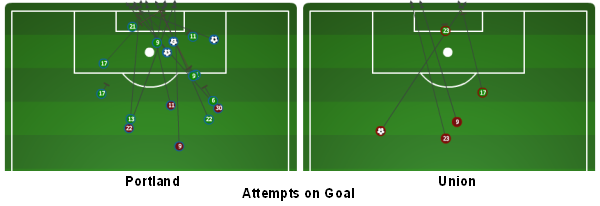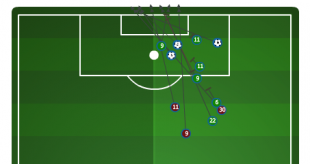Well, that wasn’t very pretty, was it?
What can we learn using the match stats from the Chalkboard at mlssoccer.com’s Match Center about the Philadelphia Union’s 3–1 loss to Portland Timbers in Monday night’s season opener?
Passing and shooting
Portland had a greater number of passes and a better passing accuracy percentage with 482 passes with a passing accuracy of 72 percent. The Union had a total of 394 passes with a passing accuracy of 70 percent. While this isn’t a huge difference in accuracy, a closer look reveals some interesting information. In the first and middle third of the field Portland’s passing accuracy was 68 percent and 79 percent, respectively, from a total of 396 attempted passes, or slightly more than the Union’s total for the entire field over the course of the game. For the Union, it was 65 percent and 75 percent in the first and middle third of the field. If you thought Portland was better able to control the buildup of play, that is what you were seeing.
At 59 percent, the Union’s passing accuracy in the final third was better than Portland’s 55 percent. But where the Union generated a total of 5 attempts on goal, only 2 of which were on target, Portland generated 17 attempts on goal, 8 of which were on target.
If we look at passing overall by each half, Portland had a total of 264 passes in the first half for a passing accuracy of 73 percent. For the Union, it was 211 passes and a passing accuracy of 72 percent. While passing accuracy for both teams dropped in the second half, Portland’s dropped just one percentage point to 72 percent. For the Union, it was a 4 percentage point drop to 68 percent.
How well did Portland capitalize on the momentum shift after they equalized? Passing accuracy overall was 72 percent for Portland and 70 percent for the Union after Andrew-Jean Baptiste equalized in the 54th minute. But when we look at accuracy in the middle and final third, the gap in accuracy increases with Portland coming in at 77 percent and the Union at 71 percent.
In the time after Portland equalized, the Union has a total of 2 shots on goal, one on target and one off target, both of which came from outside of the penalty area. Over the same period of time, Portland had 10 attempts on goal, 4 of which were on target. Of those 4 shots on target, 2 came from within the penalty area. Both resulted in goals.
How’d the new guys do?
All of us were anxious to see how the quartet of new signings would look in their first league game. So, how did they do? As you already know, it was a mixed bag.
Sticking with passing accuracy, Porforio Lopez had the best numbers in the first half at 75 percent. Gabriel Gomez was next with 71 percent, followed by Josue Martinez and Lionard Pajoy who were both at 64 percent. The passing accuracy numbers for Gomez and Pajoy both increased in the second half, with Gomez improving to 74 percent and Pajoy to 78 percent. For Lopez and Martinez, the opposite was the case. In the second half, Lopez’s accuracy plummeted 21 percentage points to 53 percent. For Martinez, it was a 14 percentage point decline to 50 percent. In fact, in the 15 minutes he was on the pitch in the second half before he was replaced by Danny Mwanga, Martinez managed just 2 passes, only 1 of which was successful.
On the bright side, Lopez was responsible for 2 of the 3 successful crosses completed from 12 attempted by the Union.
Picking on the left
 Portland clearly found space on the Union’s left as the match wore on. As mentioned above, Portland had 7 shots on target from 17 attempts. Five of those 7 shots on target came from attempts on the Union’s left, and four of those came in the second half. Of the 5 shots on target in the second half, 3 were headers, 2 of which resulted in goals. But for Freddy Adu’s goal line clearance in the 73rd minute, it would have been three for three.
Portland clearly found space on the Union’s left as the match wore on. As mentioned above, Portland had 7 shots on target from 17 attempts. Five of those 7 shots on target came from attempts on the Union’s left, and four of those came in the second half. Of the 5 shots on target in the second half, 3 were headers, 2 of which resulted in goals. But for Freddy Adu’s goal line clearance in the 73rd minute, it would have been three for three.
All of this data is meaningless without the context of tactics and formation. Check back with PSP for tactical analysis and more number crunching.


Comments